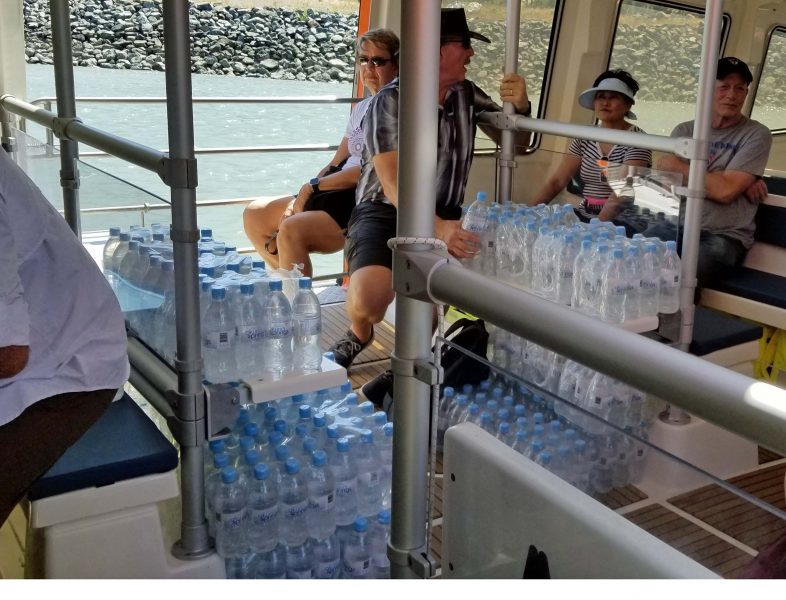Capt. James Cook stumbled on the Whitsunday Islands 49 days after Easter (Whitsunday). The islands are in the Coral Sea “amid” the Great Barrier Reef (as our tour information described them). The waters around the 74 islands in the archipelago are an almost impossible blue color. Our tour guide said people often think pictures of this area are photo-shopped, but they’re not–the beautiful color is natural.
We docked in Airlie Harbor, a city and a harbor that didn’t exist until about 25 years ago. The Whitsunday Islands have become such a tourist destination that the city and the harbor were developed for the rapidly-growing tourist industry. The islands are an extremely popular wedding destination, with the cost of a wedding averaging $47,000. Ted and I are already married, so we opted for a “Tropical Paradise Rain Forest Walk” instead.
We’ve been in rainforests in Washington and in Hawai’i, but each one is a little different. We were bused to Conway National Park, home of the largest lowland tropical rain forest in Queensland. We followed a very knowledgeable guide down a trail for over two hours. It was literally down a trail for the first half; it was up the trail for the walk back to our bus. The heat and humidity required five bottles of water for Ted and me.
It’s interesting to compare how bright, fresh, and alert our tour groups always are as we embark on our day, and how limp and sweaty we look at the end of the day in this hot, humid climate. Here’s our happy little (16 people) rainforest group starting out fresh and eager for a new adventure.
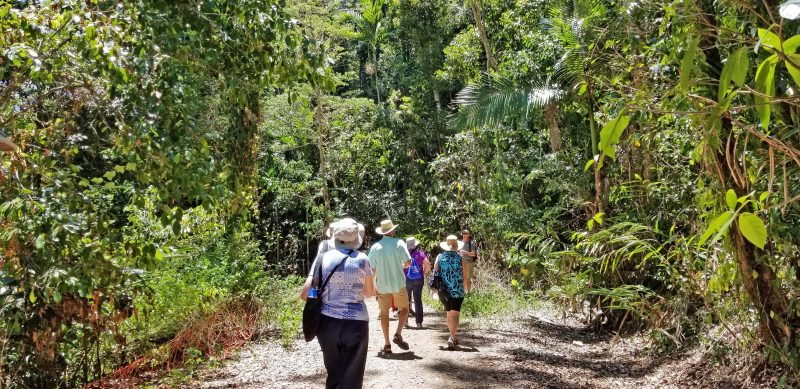
The rainforest is dense. It’s nearly impossible to imagine fighting one’s way through the thick foliage. Thank goodness someone with a bulldozer made a path for us.
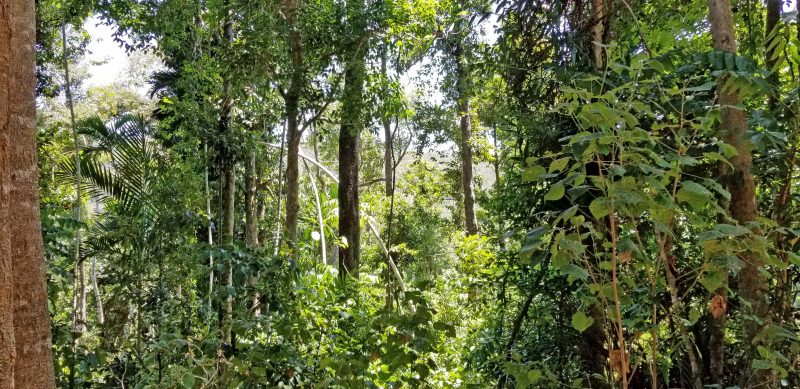
The indigenous people’s diet consisted of mostly bland or bitter foods. As our guide told us, they learned what to eat and what was poisonous by trial and error over hundreds (thousands?) of years. The guide’s example: If you’re unsure, feed it to the youngest child or the least favorite family member. If they don’t look so good the next day, cover them with stones and don’t eat that again. If they look ok, it’s safe to eat. The indigenous people’s knowledge of survival in the rainforest is very deep.
The picture below shows a “honey pot”–a beehive. It’s the pointy thing hanging from the tree. Because their diet was bland or bitter, finding a bee’s nest was like Christmas Day for the indigenous tribes. It was sweet and a wonderful treat.
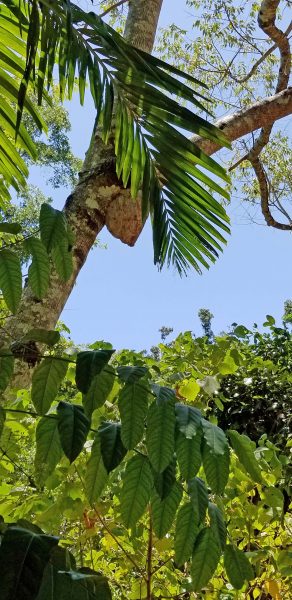
The first photo below shows the density of a ficus tree in the rainforest. Ficus is a popular fake tree in a pot that people in the U.S. use for decorative purposes. (The ones from my office are now in our basement.) You can’t see through this rainforest ficus. The second photo shows more of the ficus trunk and its top. It kind of looks like the fake ficus trunks, only much bigger.
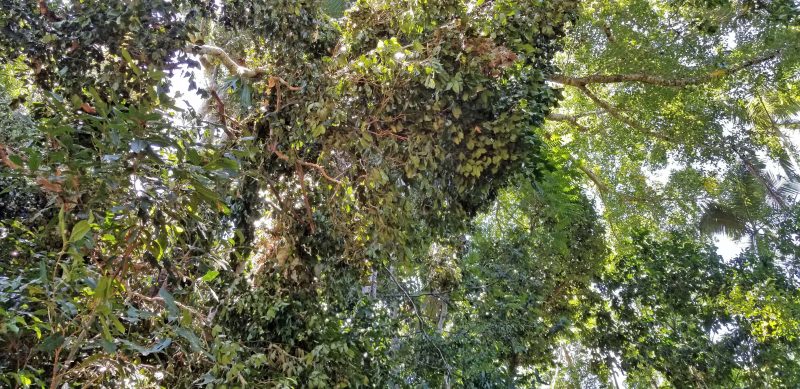
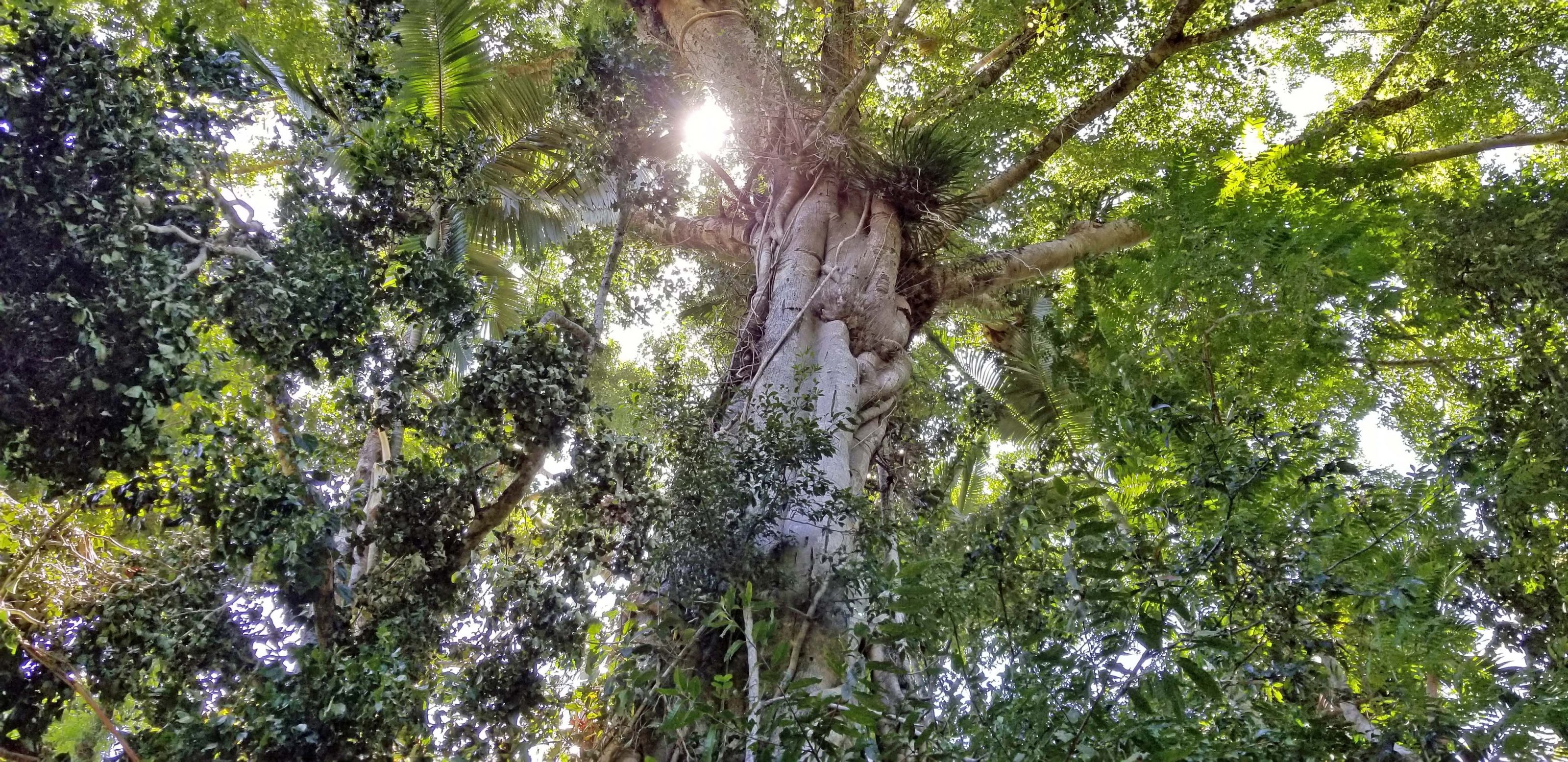
Another interesting tree we saw is called a strangling tree. It begins growing from seeds in bird poop dropped at the top of a tree. The seeds germinate and grow vines downward. When the vines reach the ground, they take root. Eventually, the strangler tree literally strangles the host tree and kills it. This one is quite large. If you look carefully, you can see daylight through the lower part of the trunk just above the person’s head. The second picture shows one of our group members who climbed inside the strangler tree’s vines and walked through them.
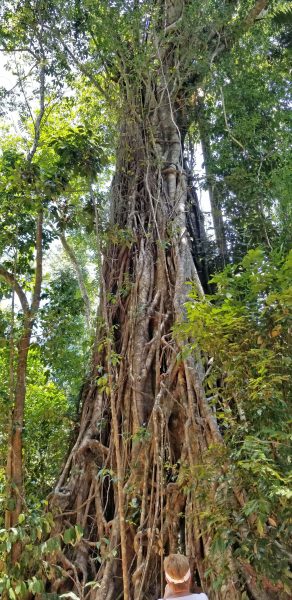
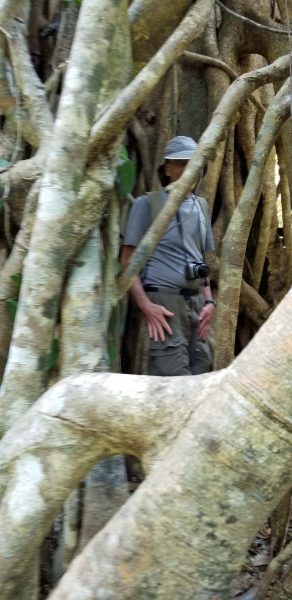
We learned that vines are an important part of the rainforest because they bind the trees together to help hold them upright. Sometimes, trees will grow crooked in search of light above the canopy. In this picture, there’s a vine on the left of the tree trunk and two smaller ones angling across the right side of the photo.

Our guide picked some leaves from a tree and gave one to each of us. When you split the leaves, they smell like fresh lemon. Mm-mm good.

After our rainforest walk, we drove to Cedar Creek Falls, described as Whitsunday Islands’ best-kept secret. How it can still be a secret, I’m not sure, since it’s a popular place for cliff-jumping. There is supposed to be a “majestic” waterfall and a pool under the waterfall for swimming, water (not weather) permitting. This is the dry season, so there is no waterfall. Look carefully in the upper center of the picture to find some people in swimsuits on a high rock ledge. This is the point from which people jump into the pool below. Then look at the high water mark at the bottom of the rock face. This is one of the reasons they did not jump.
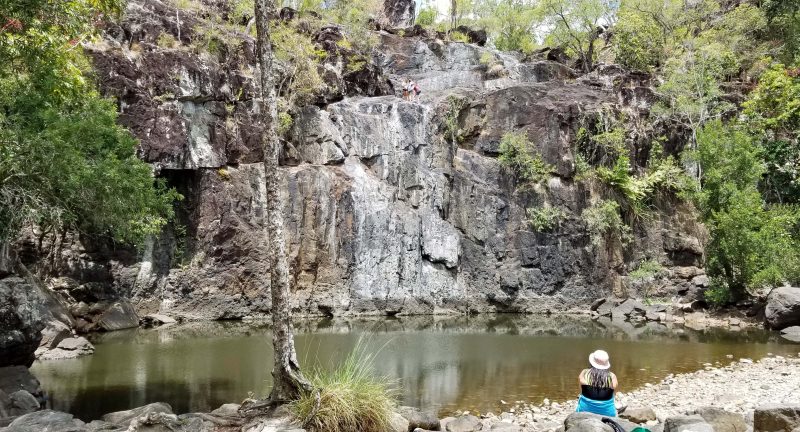
We ate lunch at the nonexistent waterfall. It tasted as good as it looks. After sweating a lot while we walked, the moisture in the fruits and veggies was welcome and tasty. There was even a sparking wine beverage for those who wanted some.
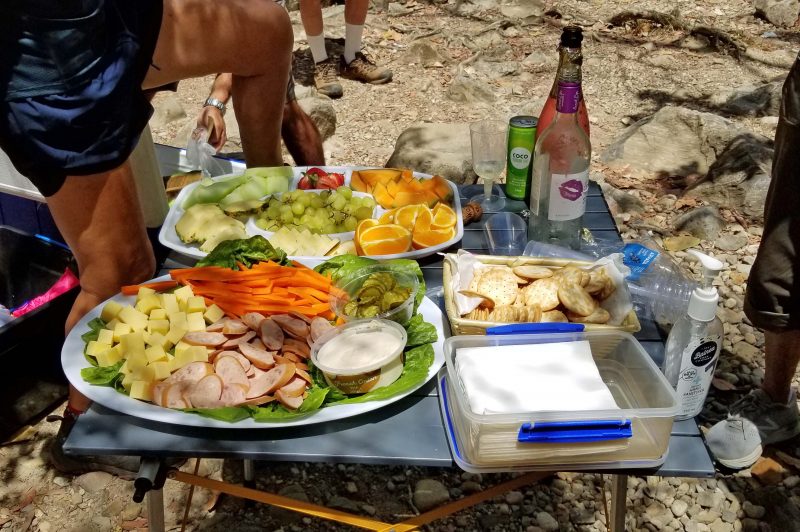
We enjoyed some sightseeing on our way back to the ship, including a lot of sugar cane fields. Not only is Australia one of the world’s leading sugar exporters, but Queensland leads the rest of Australia in sugar production. This is a sugar cane field.
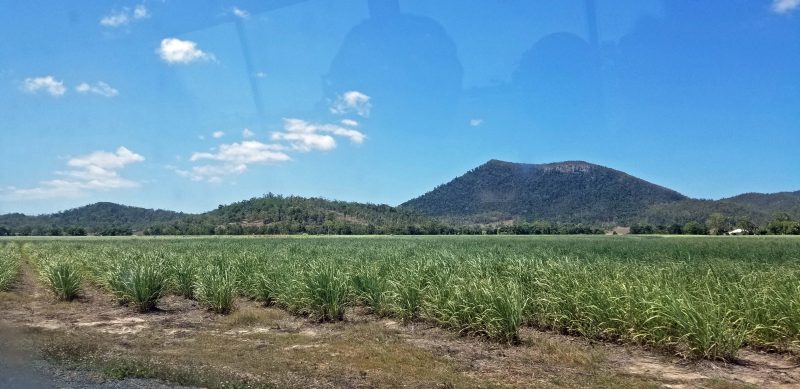
We had just enough time to stop at a high point for an overview of Airlie.
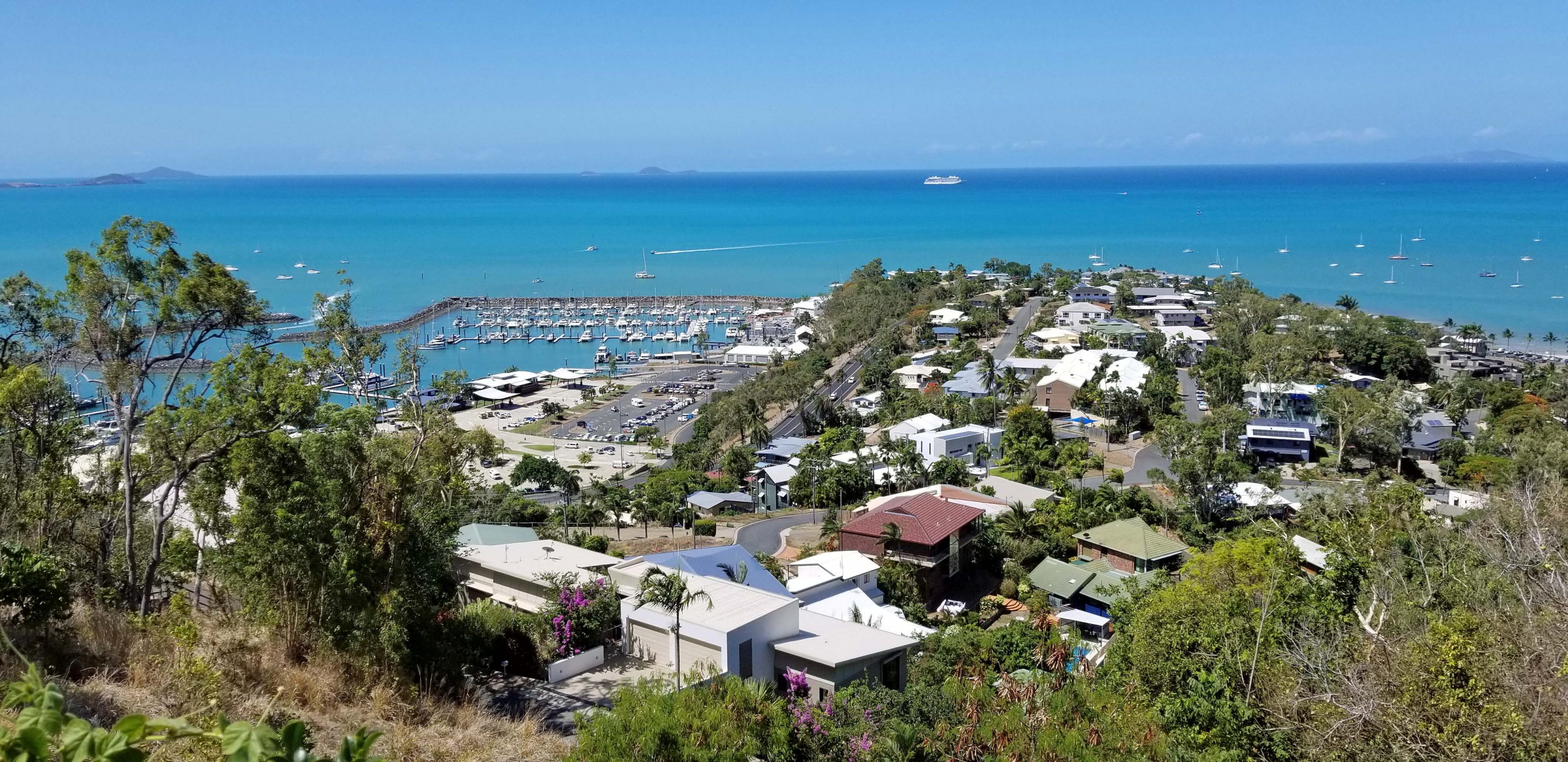
On a cruise we took with a different company, they nickel-and-dimed us for everything except meals. On a ship with 2,000 passengers, bottled water had to be purchased, and there was only one spigot on the entire ship (in a secluded out-of-the-way location) to fill water bottles at no cost.
Viking, the line we’re sailing on now, does the opposite: yes, they charge more up front, but they’re very generous onboard with many amenities. One example is bottled water. They provide as much bottled water as we want in our rooms and we may take as much as we want when we leave for an excursion. In addition, they have more water at our destination points, on the tour buses, and on the tenders. When we boarded our tender today, hot and thirsty from our rain forest walk (on which we drank five bottles of water), we were presented with more water at the dock and were greeted by this water on the tender. Overall, I bet it’s cheaper to provide water than to pay for medical care for dehydration or heat exhaustion. Thank you, Viking.
